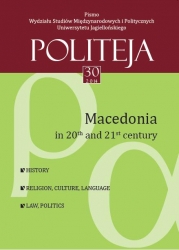The Role of Stabilisation Missions in the Process of Police Reform in the Former Yugoslav Republic of Macedonia
The Role of Stabilisation Missions in the Process of Police Reform in the Former Yugoslav Republic of Macedonia
Author(s): Daniel WilkSubject(s): Politics / Political Sciences
Published by: KSIĘGARNIA AKADEMICKA Sp. z o.o.
Keywords: stabilisation mission; the mission of the police; OSCE; European Union; PROXIMA; EUPAT; CONCORDIA; National Liberation Army; the conflict in Macedonia
Summary/Abstract: In 2001, the increasing tension led to a threat to Macedonian sovereignty and territorial integrity due to the events that took place in the north‑western regions of the country bordering Albania and Kosovo. The actions of Albanian separatists associated with National Liberation Army that aimed at making Albanian and Macedonian nationalities equal within the Republic resulted in an increase of anti‑Albanian attitudes that contributed to the Macedonian‑Albanian conflict. The six‑month fight was ended on 13 August 2001 when the peace agreement was signed in Ohrid. The agreement, which was accepted by both sides of the conflict, was more favourable for the Albanians since it made their status as citizens almost equal to that of Macedonians. A growing tension among the Albanian minority forced immediate implementation of the decisions included in the Ohrid Agreement. The European Union in cooperation with the OSCE and NATO played a key role in the process of stabilising the socio‑political situation. The police reform in the Republic of Macedonia was a crucial element of the Ohrid Agreement. The changes were to ensure proportional representation of all nationalities comprising the Macedonian society in law enforcement services. The European Union and the Organization for Security and Cooperation in Europe conducted three stabilisation missions: one was a military mission – CONCORDIA, and two were police missions: PROXIMA and EUPAT.
Journal: Politeja - Pismo Wydziału Studiów Międzynarodowych i Politycznych Uniwersytetu Jagiellońskiego
- Issue Year: 11/2014
- Issue No: 30
- Page Range: 333-345
- Page Count: 13

